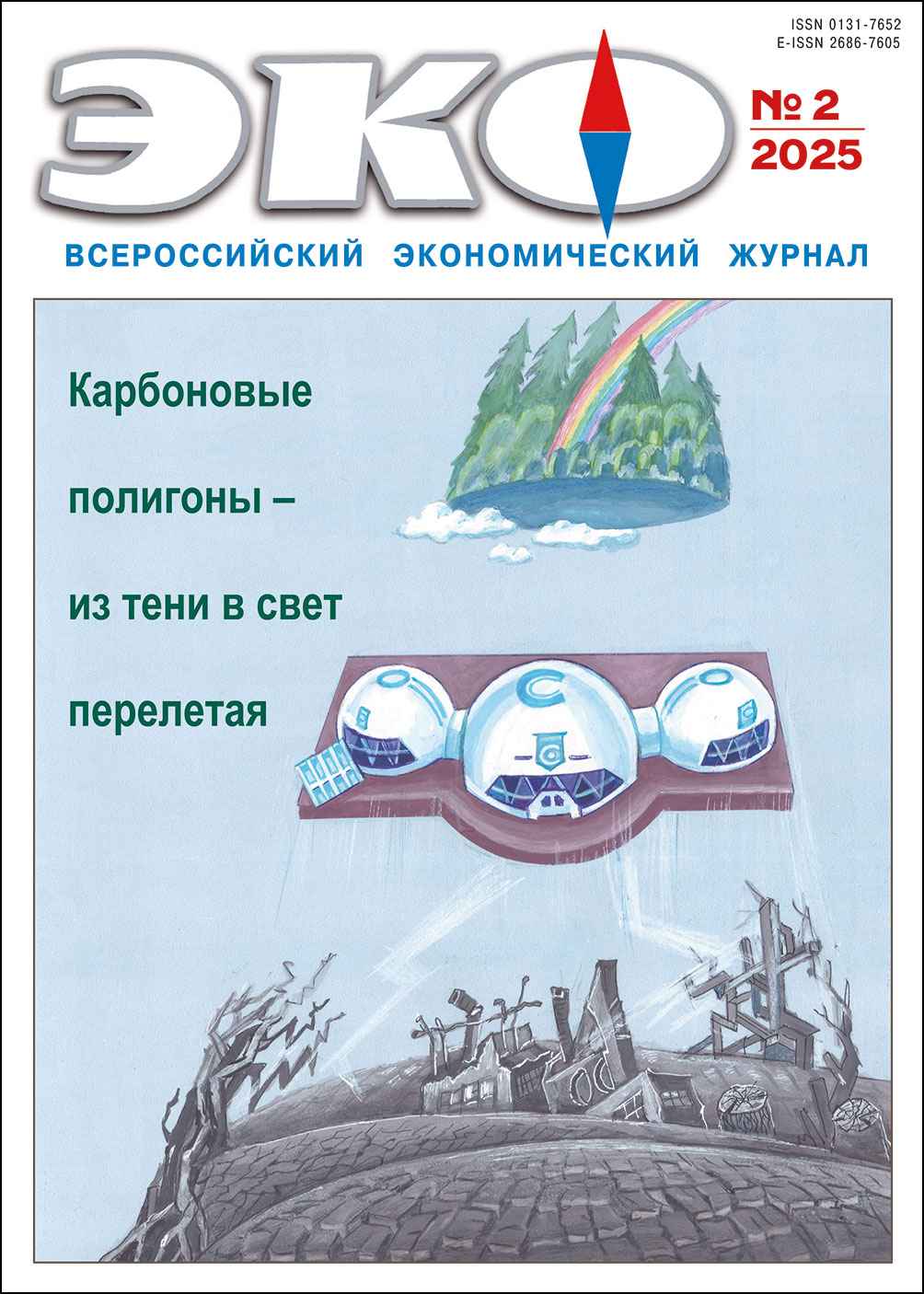REGIONAL DEVELOPMENT
Assessment of Interregional Disparities in the Context of Spatial Development Leveling Policy of the Russian Federation
Published 2025-04-02
Keywords
- spatial development; spatial inequality; regional asymmetry; territorial justice; leveling; regional policy
How to Cite
1.
Antipin И, Vlasova Н, Shishkina Е. Assessment of Interregional Disparities in the Context of Spatial Development Leveling Policy of the Russian Federation. ECO [Internet]. 2025 Apr. 2 [cited 2025 Sep. 4];55(2):197-213. Available from: https://ecotrends.ru/index.php/eco/article/view/4855
Abstract
The paper describes the results of comparative analysis of socio-economic development of Russian regions, that allow assessing the effectiveness of the implemented policy of smoothing spatial differences. It is shown that the problem of interregional inequality and uneven development remains relevant, especially in terms of certain indicators. According to the authors, when implementing measures of state support, special attention should be paid not only to the regions-outsiders, but also to the regions that have a median position in key parameters. In this regard, the issues of territorial zoning are actualized, taking into account the interdependencies of the subjects of the Russian Federation, their cooperation, as well as the assessment of socio-economic efficiency of management decisions.References
- Антипин И.А., Шишкина Е.А. Стратегическое управление диспропорциями социально-экономического и пространственного развития регионов России // Научные труды Вольного экономического общества России. 2024. Т. 247. № 3. С. 179–201. DOI: 10.38197/2072–2060–2024–247–3–179–201. – EDN QJOKSO
- Барбашова Н.Е. Создает ли методика межбюджетного выравнивания отрицательные стимулы для инфраструктурного развития регионов? Финансы: теория и практика. 2021. № 25(1). С. 22–34.
- Бахтизин А. Р., Бухвальд Е. М., Кольчугина А. В. Выравнивание регионов в России: иллюзии программы и реалии экономики // Вестник Института экономики Российской академии наук. 2016. № 1. С. 76-91. – EDN VLFOET.
- Бухвальд Е.М. Управление пространственным развитием российской экономики: цели и инструменты // Управленец. 2020. Т. 11. № 6. С. 2–14.
- Глущенко К.П. Где на Руси жить хорошо? // ЭКО. 2022. № 6(576). С. 168–177. DOI: 10.30680/ECO0131–7652–2022–6–168–177
- Гонтарь Н.В. Подходы к формированию концепции территориальной справедливости // Социально-экономическая география. Вестник Ассоциации российских географов-обществоведов. 2013. № 2. С. 245–259.
- Дерюгин А.Н. Выравнивание регионов: сохраняются ли стимулы к развитию? // Экономическая политика. 2016. Т. 11, № 6. С. 170–191.
- Зотиков Н.З. Проблемы социально-экономического выравнивания промышленных, сырьевых, агропромышленных регионов (на примере Уральского федерального округа) // Вестник Челябинского государственного университета. 2023. № 8 (478). С. 73–86.
- Колесников Ю.С., Дармилова Ж.Д. Совмещение принципов эффективности и социальной справедливости в региональной экономической политике как императив управления пространственным развитием России // Journal of Economic Regulation. 2014. Т. 5, № 2. С. 70–81.
- Колодина Е.А. Исследование результативности выравнивающей региональной политики в Российской Федерации // Региональная экономика и управление: электронный научный журнал. 2019. № 4 (60). С. 7.
- Морковкин Д.Е., Строев П.В., Шапошников А.И. Финансовая поддержка регионов как инструмент выравнивания бюджетной̆ обеспеченности субъектов Российской̆ Федерации //Финансы: теория и практика. 2019. Т. 23. № . 4. С. 57–68.
- Паршутина И.Г., Соколова Н.Н., Захаркина Н.В. Совершенствование методики оценки уровня социально-экономического развития регионов для определения направлений их "выравнивания" // Вестник ОрелГИЭТ. 2018. № 1(43). С. 24–32.
- Швецов А.Н. «Точки роста» или «черные дыры»? (К вопросу об эффективности применения "зональных" инструментов госстимулирования экономической динамики территорий) // Российский экономический журнал. 2016. № 3. С. 40–61.
- Cerqua, A., Pellegrini, G. (2018). Are we spending too much to grow? The case of Structural Funds. Journal of Regional Science. Vol. 58. No. 3. Pp. 535–563. DOI:10.1111/jors.12365
- Crescenzi, R., Giua, M. (2020). One or many Cohesion Policies of the European Union? On the differential economic impacts of Cohesion Policy across member states. Regional Studies. Vol. 54. No. 1. Pp. 10–20. DOI:10.1080/00343404.2019.1665174
- Demeterova, B., Fischer, T., Schmude, J. (2020). The right to not catch up – transitioning European territorial cohesion towards spatial justice for sustainability. Sustainability. Vol. 12. No. 11. P. 4797.
- Di Caro, P., Fratesi, U. (2022). One policy, different effects: Estimating the region‐specific impacts of EU cohesion policy. Journal of Regional Science. Vol. 62. No. 1. Pp. 307–330. DOI:10.1111/jors.12566
- Doerrenberg, P., Peichl A. (2014). The impact of redistributive policies on inequality in OECD countries. Applied Economics. Vol. 46. No. 17. Pp. 2066–2086. DOI: 10.1080/00036846.2014.892202
- Ehrlich, M., Overman, H.G. (2020). Place-based policies and spatial disparities across European cities. Journal of Economic Perspectives. Vol. 34. No. 3. Pp. 128–149. DOI: 10.1257/jep.34.3.128.
- Fratesi, U., Perucca, G. (2019). EU regional development policy and territorial capital: A systemic approach. Papers in Regional Science. Vol. 98. No. 1. Pp. 265–281. DOI: 10.1111/pirs.12360
- Gniza, J., Abraham, M., Lehmann, I., Lorek, K. (2022). Expecting equality or efficiency? A factorial survey on the justice perception of regional redistributive policies. Regional Studies. Vol. 56. No. 11. Pp. 1934–1948. DOI:10.1080/00343404.2021.2018129
- Israel, E., Frenkel, A. (2018). Social justice and spatial inequality: Toward a conceptual framework. Progress in Human Geography. Vol. 42. No. 5. Pp. 647–665.
- Madanipour, A., Shucksmith, M., Brooks, E. (2022). The concept of spatial justice and the European Union’s territorial cohesion. European Planning Studies. Vol. 30. No. 5. Pp. 807–824. DOI:10.1080/09654313.2021.1928040
- Moroni, S. (2020). The Just City. Three Background Issues: Institutional Justice and Spatial Justice, Social Justice and Distributive Justice, Concept of Justice and Conceptions of Justice. Planning Theory. Vol. 19. No. 3. Pp. 251–267. DOI:10.1177/1473095219877670
- Olayele, B. F., Soo, K. T. (2020). Redistributive fiscal policies and regional economic disparities. Cogent Economics & Finance. Vol. 8. No. 1. Pp. 1853326. DOI:10.1080/23322039.2020.1853326
- Percoco, M. (2017). Impact of European Cohesion Policy on regional growth: Does local economic structure matter? Regional Studies. Vol. 51. No. 6. Pp. 833–843. DOI:10.1080/00343404.2016.1213382
- Pirie, G. H. (1983). On spatial justice. Environment and Planning A. Vol. 15. No. 4. Pp. 465–473.
- Rodríguez-Pose, A., Garcilazo, E. (2015). Quality of government and the returns of investment: Examining the impact of cohesion expenditure in European regions. Regional Studies. Vol. 49. No. 8. Pp. 1274–1290. DOI:10.1080/00343404.2015.1007933
- van Vulpen, B. (2023). The ‘right’policy for regional development: seeking spatial justice in the Dutch case of the region deals. European Planning Studies. Vol. 31. No. 9. Pp. 1823–1841. DOI: 10.1080/09654313.2022.2140584

